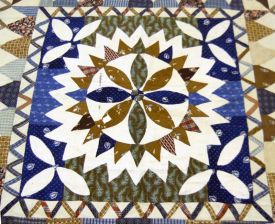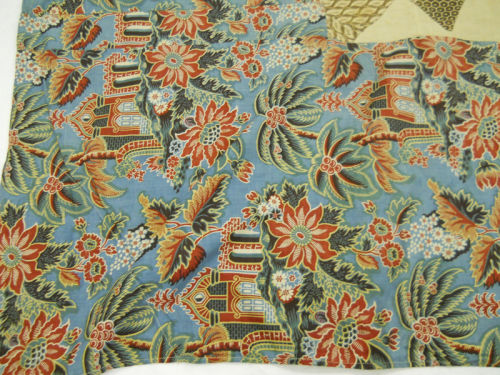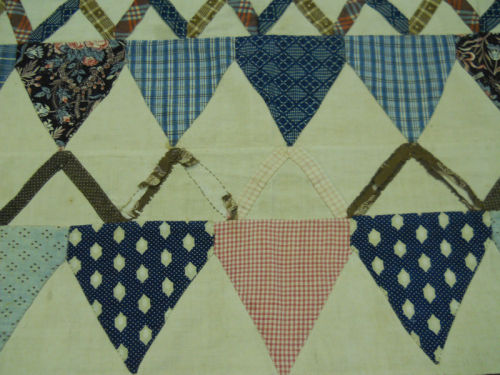Exploring the Challans Coverlet
Published: Saturday, 14th April 2012 12:23 PM

History student Claire Price delves into the history of one of the Quilters' Guild's most recent acquisitions. Read her fascinating journey to discover the potential maker of the coverlet and what their life could have been like at the time the coverlet was made.
What lies beneath the coverlet?
Uncovering the history of the Quilters’ Guild’s latest acquisition.
I’ve been tasked with delving into the history of the Challans coverlet – so called because, helpfully for me, it has the name ‘S. Challans’ and the year 1811 cross-stitched in the centre panel.
The Challans coverlet is an early appliqué piece, with a basic cream cotton background and dress fabrics sewn straight on top: no padding of course, making it a coverlet rather than a quilt. Its frame design, the print of the fabrics used and the way it was made all show its place within quilting history, but what we were really interested in here was the opportunity to look at its social history – who made it, what their life was like, and the times they lived through.
I could have just taken the name and date and researched that separately from the coverlet itself, but I was really keen to see how much supporting evidence could be found in the artefact. As it turns out - quite a lot! We had no extra provenance information anyway, so a thorough visual examination was necessary.
The piece initially seemed very unplanned, and difficulties with accurate measuring and working out corners were apparent. This suggested to me a woman who had little or no formal education – but who could embroider her name and a date, even if just from a pattern. Closer inspection revealed a little more planning than first thought. All of the fabrics had been chosen symmetrically, either across the central circle, or working outwards from the middle of a row.
The amount of fabric used, and their slightly older style, suggests the coverlet was made from old dress scraps. The border is the only furnishing fabric used, and that too could have been a remnant, or possibly bought to finish the piece off.
But, onto the real detective work – finding the maker of the Challans coverlet. I used mainly birth, death and marriage certificates to locate anyone with the name ‘S. Challans’ living in 1811. Luckily, the surname was fairly uncommon and I narrowed it down to twelve options, but of these, seven were stronger candidates. The records confirmed that the maker was a woman, as expected, and brilliantly, all the possible ‘S. Challans’ lived within a small region of Lincolnshire.
This meant that I could safely look into Lincolnshire social history from the early nineteenth century without placing any history onto the coverlet that wasn’t appropriate. My first consideration though was more specific: what was the status of the Challans family and what was the occupation of the head of the house? Census records from 1841 (the first to include names) revealed that the likely occupation was farming, the biggest employer in Lincolnshire, so no surprises there. However, farmers ranged from labouring classes to almost middling classes in social scale, so I wondered if I could narrow it down further. A mixture of Land Tax Assessments, occupation records and the coverlet itself as a decorative rather than practical piece hints at a family who were not at the bottom of society’s ladder – maybe a small farmer who owned some land, or rented his farm.
Evidence from the coverlet suggested the maker was uneducated, and researching a history of schools in rural Lincolnshire backed this theory up. It was unlikely that poorer families would have had any access to schooling before 1812. Girls would have learnt to sew and housekeep from elder generations.
This coverlet was not produced in the genteel society of morals and mid-century Victorian standards though. Society in Lincolnshire was still very much Georgian in 1811, and the industrial revolution was yet to make a big impact. This is particularly apparent through popular entertainment. Vicious events like cock-fighting, bull-running, and public hangings drew large crowds into the nearby towns. Other entertainments, such as village feasts, horse fairs and hiring days where farmers went to gather a workforce for the season, all encompassed a lot of drinking and behaviour that would later be deemed immoral.
Although it would be guess work to match any individual person to the making of the coverlet, the evidence provides an accurate background to the general lifestyle of the coverlet maker. It was great fun and very rewarding to be able to uncover the life and history of the coverlet, solely from the evidence of the fabric.
Copyright Claire Price.
 Outer border of furnishing fabric on the Challans Coverlet
Outer border of furnishing fabric on the Challans Coverlet
 Triangle and zigzag applique frames
Triangle and zigzag applique frames